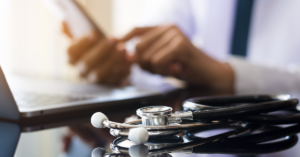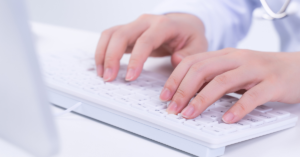Are paper-based records slowing down your practice? In today’s fast-paced healthcare environment, nurses and medical professionals in the Philippines are under constant pressure to provide quality care while juggling administrative tasks. Electronic medical records (EMR) in nursing is revolutionizing patient care by streamlining documentation, improving accuracy, and enhancing workflow efficiency.
A study published in the Journal of Medical Internet Research found that EMR adoption reduced documentation errors by 40% and significantly improved patient outcomes (PubMed). With technology advancing rapidly, switching to a paperless system is no longer a luxury—it’s a necessity.
Why EMRs Are a Game-Changer for Nursing
Traditional paper records come with multiple challenges—lost files, illegible handwriting, and time-consuming retrieval. Nurses spend a significant portion of their shift on documentation, reducing time available for direct patient care. An EMR system automates documentation, allowing nurses to focus on patient interactions instead of paperwork.
Additionally, EMRs enhance collaboration among healthcare teams. Instead of waiting for physical charts, physicians, nurses, and specialists can instantly access real-time patient data. This seamless communication improves treatment accuracy and reduces the risk of medical errors.
Key Benefits of EMRs for Nurses and Healthcare Providers
1. Faster and More Accurate Documentation
With EMRs, nurses can input patient data quickly using pre-set templates, dropdown menus, and voice-to-text features. This reduces the risk of missing critical details and ensures standardized documentation across healthcare settings.
2. Enhanced Patient Safety
Medication errors are a major concern in healthcare. An EMR system with built-in alerts can notify nurses of potential drug interactions, incorrect dosages, or patient allergies—ensuring safer medication administration.
3. Improved Workflow Efficiency
Paper-based records require storage, retrieval, and manual updates. EMRs eliminate these inefficiencies by enabling instant access to patient history, lab results, and treatment plans. This reduces administrative burdens and allows nurses to dedicate more time to patient care.
4. Compliance with Healthcare Regulations
The Data Privacy Act of 2012 (RA 10173) mandates strict security measures for handling patient records in the Philippines. A reliable EMR system ensures compliance by encrypting data, restricting access, and maintaining audit trails.
Ready to Transition to a Paperless System?
Moving to electronic medical records nursing is a smart investment for clinics, hospitals, and private practitioners. Schedule a demo today to experience how EMRs can enhance efficiency and improve patient care.
What Is Electronic Medical Records in Nursing?
Electronic medical records (EMR) in nursing refer to digital patient records that replace traditional paper charts. These systems enable healthcare professionals to document, retrieve, and manage patient data in real time, improving efficiency and patient care. Unlike handwritten records, which can be prone to errors, EMRs offer a structured and secure way to store medical information, ensuring that healthcare providers always have accurate, up-to-date data at their fingertips.
A well-implemented EMR system benefits nurses and healthcare providers in several key ways:
1. Reducing Documentation Time
Nurses often spend a significant portion of their shift on documentation, which can take away valuable time from direct patient care. With EMRs, documentation becomes faster and more streamlined through pre-set templates, auto-fill options, and voice recognition. This ensures that nurses can focus more on patient interactions rather than paperwork.
2. Eliminating Handwriting Errors and Lost Records
Illegible handwriting has long been a source of medical errors. With digital records, everything is clearly typed and standardized, reducing the risk of misinterpretation. Additionally, records are securely stored in a centralized system, eliminating the common problem of misplaced or lost charts.
3. Improving Communication Across Healthcare Teams
Seamless coordination between nurses, doctors, and specialists is crucial for effective patient care. EMRs provide instant access to patient histories, lab results, and treatment plans, ensuring that all healthcare professionals are on the same page. This minimizes delays in decision-making and enhances overall patient outcomes.
4. Ensuring Compliance with Healthcare Regulations
In the Philippines, data privacy is a top concern. The Data Privacy Act of 2012 (RA 10173) mandates strict guidelines for handling patient information. EMRs help healthcare providers comply with these regulations by offering encrypted data storage, access controls, and automated audit trails. This not only protects patient confidentiality but also ensures clinics and hospitals meet legal requirements.
5. Enhancing Patient Outcomes
When nurses have easy access to comprehensive patient records, they can make informed decisions faster. This improves treatment accuracy, reduces errors, and enhances patient satisfaction. With an efficient EMR system, Filipino healthcare providers can deliver better, more coordinated care, leading to healthier communities.
Transitioning to electronic medical records nursing is a smart step towards modernizing healthcare. Are you ready to experience the benefits of a paperless system? Explore EMR solutions today.
The Impact of EMR on Nursing Efficiency
The role of nurses in patient care is critical, but administrative tasks often take up a large portion of their time. Electronic medical records (EMR) nursing significantly improves efficiency by reducing documentation time, enhancing communication, and ensuring compliance with healthcare regulations.
1. Faster Documentation and Reduced Errors
A survey conducted by the American Journal of Nursing revealed that nurses spend up to 35% of their shift on documentation. Traditional paper records require manual data entry, frequent double-checking, and extensive paperwork—all of which slow down workflows. With EMRs, this time can be cut significantly, allowing nurses to focus on direct patient care rather than administrative tasks.
Additionally, built-in error detection and automated prompts minimize incorrect prescriptions, overlooked symptoms, and missing information. EMRs also provide real-time alerts for drug interactions or allergies, ensuring nurses can make safer, more informed decisions when administering treatments.
2. Improved Coordination Between Nurses and Physicians
Effective teamwork is essential in healthcare, and EMRs enhance communication between nurses, physicians, and other medical professionals. With digital records, there’s no need to flip through paper charts, wait for lab results to be delivered, or track down missing records. Instead, all patient information—medical history, lab results, and prescribed medications—is instantly available.
This real-time access improves decision-making, reduces the risk of miscommunication, and enhances overall patient care. For example, if a doctor updates a patient’s medication plan, nurses can see the changes immediately, preventing delays or administration errors.
3. Enhanced Compliance and Security
Philippine healthcare facilities must adhere to strict data privacy laws to protect patient information. Under the Data Privacy Act of 2012 (RA 10173), medical institutions must ensure patient records are securely stored and accessed only by authorized personnel. A robust EMR system helps clinics and hospitals comply with these regulations by offering:
- Encrypted data storage to prevent breaches.
- User access controls to limit unauthorized viewing.
- Automated audit trails to track who accessed patient records and when.
Unlike paper records, which are vulnerable to loss, theft, or damage, digital EMRs ensure patient information remains safe and confidential.
By adopting electronic medical records nursing, Filipino healthcare providers can streamline operations, enhance patient safety, and improve overall efficiency. Ready to transition to a paperless system? Explore EMR solutions today.
Key Features of an Effective EMR System for Nurses
To fully benefit from electronic medical records, healthcare providers should look for an EMR system tailored for nursing workflows. Some essential features include:
1. Intuitive Charting and Documentation
A good EMR should have easy-to-use templates for SOAP notes, nursing assessments, and progress reports. Customizable fields ensure that nurses can document quickly without missing critical details.
2. Automated Scheduling and Task Management
Missed follow-ups and delayed treatments can compromise patient care. With automated reminders and scheduling tools, nurses can stay on top of patient rounds, medication administration, and discharge planning.
3. Medication Management and Alerts
A study in the Journal of Patient Safety found that medication errors are responsible for 7,000 deaths annually. EMRs with built-in medication tracking can alert nurses about potential drug interactions, missed doses, or duplicate prescriptions.
4. Integration with Laboratory and Imaging Systems
With seamless integration, nurses can instantly access lab results and radiology reports without manually requesting them. This speeds up diagnoses and improves treatment efficiency.
5. Mobile Access for On-the-Go Updates
With mobile-friendly EMR solutions, nurses can update patient records directly from their devices. This reduces the need to return to a workstation, making patient care more responsive and efficient.
How to Transition to a Paperless EMR System Smoothly
Switching to an electronic medical records system doesn’t have to be overwhelming. Here are some best practices:
1. Choose an EMR That Aligns with Your Needs
Not all EMR systems are created equal. Filipino clinics and hospitals need an EMR that is user-friendly, compliant with local regulations, and integrates well with existing workflows. Schedule a demo to see which features best fit your practice.
2. Provide Proper Training for Nurses and Staff
Successful EMR adoption depends on how well the staff adapts to the system. Comprehensive training ensures that nurses and healthcare workers can use the system effectively without frustration. Watch training videos for guidance on seamless implementation.
3. Ensure Data Migration and Security Compliance
Migrating from paper to digital records must be handled carefully. A reliable EMR provider will assist in securely transferring data, ensuring compliance with the Philippines’ health data privacy laws.
4. Monitor and Optimize System Performance
Regular updates and feedback sessions with staff help refine workflows. A responsive support team ensures that any issues are resolved quickly to keep operations running smoothly.
The Future of Nursing with EMRs in the Philippines
As more Filipino healthcare providers transition to electronic medical records nursing, patient care will become more efficient, accurate, and accessible. Nurses will have more time to focus on what truly matters—caring for their patients.
If you’re ready to experience the benefits of a paperless system, explore your EMR options today. With the right technology, your practice can enhance efficiency, compliance, and patient safety—all while reducing administrative stress.





